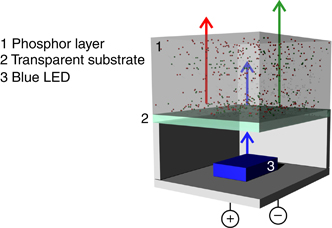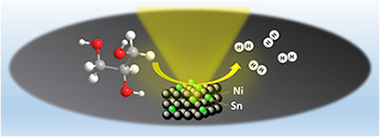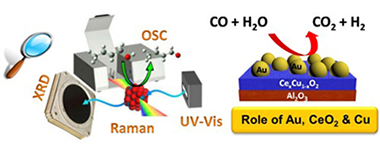Artículos SCI
2016
2016
Reactividad de Sólidos
Template-Assisted Hydrothermal Growth of Aligned Zinc Oxide Nanowires for Piezoelectric Energy Harvesting Applications
Ou, C; Sanchez-Jimenez, PE; Datta, A; Boughey, FL; Whiter, RA; Sahonta, SL; Kar-Narayan, SACS Applied Materials & Interfaces, 8 (2016) 13678-13683
Show abstract ▽

A flexible and robust piezoelectric nanogenerator (NG) based on a polymer-ceramic nanocomposite structure has been successfully fabricated via a cost-effective and scalable template assisted hydrothermal synthesis method. Vertically aligned arrays of dense and uniform zinc oxide (ZnO) nanowires (NWs) with high aspect ratio (diameter similar to 250 nm, length similar to 12 mu m) were grown within nanoporous polycarbonate (PC) templates. The energy conversion efficiency was found to be similar to 4.2%, which is comparable to previously reported values for ZnO NWs. The resulting NG is found to have excellent fatigue performance, being relatively immune to detrimental environmental factors and mechanical failure, as the constituent ZnO NWs remain embedded and protected inside the polymer matrix.
Junio, 2016 | DOI: 10.1021/acsami.6b04041
Reactividad de Sólidos
Mechanochemically synthesized nanocrystalline ternary CuInSe2 chalcogenide semiconductor
Dutkova, E; Sayagues, MJ; Kovac, J; Kovac, J; Bujnakova, Z; Briancin, J; Zorkovska, A; Balaz, P; Ficeriova, JMaterials Letters, 173 (2016) 182-186
Show abstract ▽

The synthesis of nanocrystalline ternary CuInSe2 particles prepared by high-energy milling in a planetary mill in an argon atmosphere from copper, indium and selenium was reported. CuInSe2 particles crystallize in the tetragonal structure with the crystallite size of about 30.5 nm. The Raman spectrum of CuInSe2 nanoparticles shows a strong peak at 176 cm−1 corresponds to the A1 phonon mode of tetragonal CuInSe2 chalcopyrite. HRTEM measurements also revealed the presence of nanocrystals with the size of 10–20 nm with the tendency to form agglomerates. The optical absorption study shows that nanoparticles have direct optical band gap energy of 1.8 eV. The quantum size effect of the particles was confirmed also by PL measurement.
Junio, 2016 | DOI: 10.1016/j.matlet.2016.03.051
Materiales Ópticos Multifuncionales
Metallic nanostructures for efficient LED lighting
Lozano, G; Rodriguez, SRK; Verschuuren, MA; Rivas, JGLight: Science and Applications, 5 (2016) e16080
Show abstract ▽

Light-emitting diodes (LEDs) are driving a shift toward energy-efficient illumination. Nonetheless, modifying the emission intensities, colors and directionalities of LEDs in specific ways remains a challenge often tackled by incorporating secondary optical components. Metallic nanostructures supporting plasmonic resonances are an interesting alternative to this approach due to their strong light-matter interaction, which facilitates control over light emission without requiring external secondary optical components. This review discusses new methods that enhance the efficiencies of LEDs using nanostructured metals. This is an emerging field that incorporates physics, materials science, device technology and industry. First, we provide a general overview of state-of-the-art LED lighting, discussing the main characteristics required of both quantum wells and color converters to efficiently generate white light. Then, we discuss the main challenges in this field as well as the potential of metallic nanostructures to circumvent them. We review several of the most relevant demonstrations of LEDs in combination with metallic nanostructures, which have resulted in light-emitting devices with improved performance. We also highlight a few recent studies in applied plasmonics that, although exploratory and eminently fundamental, may lead to new solutions in illumination.
Junio, 2016 | DOI: 10.1038/lsa.2016.80
Química de Superficies y Catálisis
Promoting effect of Sn on supported Ni catalyst during steam reforming of glycerol
Bobadilla, LF; Romero-Sarria, F; Centeno, MA; Odriozola, JAInternational Journal of Hydrogen Energy, 41 (2016) 9234-9244
Show abstract ▽

The promoting effect of Sn on the catalytic performance of supported Ni catalyst in the reaction of glycerol steam reforming was studied. The physico-chemical properties of the prepared samples were investigated by X-ray fluorescence (XRF), BET surface area, in situ X-ray diffraction (XRD), laser Raman spectroscopy, X-ray photoelectron spectroscopy (XPS), scanning electron microscopy (SEM) and temperature-programmed oxidation (TPO) techniques. The characterization results of the samples after reduction treatment (in the same conditions than the activation before catalytic activity measurements) revealed the formation of NiSn alloy. The Sn-doped catalyst exhibited a high activity and it was demonstrated that the Sn addition increase the catalyst stability and durability by decreasing the coke deposition.
Junio, 2016 | DOI: 10.1016/j.ijhydene.2016.04.119
Química de Superficies y Catálisis
The role of Au, Cu & CeO2 and their interactions for an enhanced WGS performance
Reina, TR; Ivanova, S; Centeno, MA; Odriozola, JAApplied Catalysis B: Environmental, 187 (2016) 98-107
Show abstract ▽

The WGS reaction over multicomponent Au/Ce1-xCuxO2/Al2O3 catalysts is studied in this work. The systems are carefully designed aiming to take advantage of every active phase included in the formulation: gold, ceria and copper. Special emphasis is given to the CeO2-CuO synergy and its influence on the displayed catalytic performance with and without gold. To this aim a meaningful correlation between the physicochemical properties of the mixed materials and their activity/stability is proposed. In general terms the developed catalysts present high activity under realistic WGS reaction conditions, with fairly good long term stability. In addition, the systems successfully withstand start-up/shut-downs situations, indispensable requisite for real applications in the field of pure hydrogen production for fuel cell goals.
Junio, 2016 | DOI: 10.1016/j.apcatb.2016.01.031
- ‹ anterior
- 221 of 420
- siguiente ›














